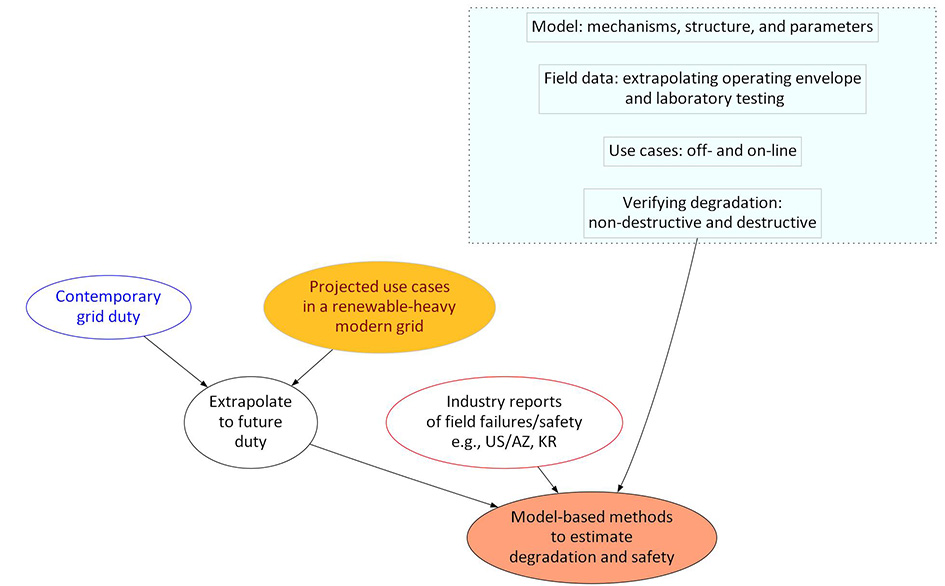Background
Grid modernization has become a new refrain in the electric utility industry. The electric grid is aging, and its modernization is imperative. The many facets of grid modernization include:
A changing mix of generation, including clean, distributed, and variable energy.
Reliability and resiliency of grids in the face of climate change and cyber/physical threats.
Electrification of transportation.
Interconnectivity, interoperability (information exchange), and distributed/edge control.
Market-driven management of supply and demand, and (f) physical infrastructure for energy transport.
Many of these aspects of a flexible, sustainable, and affordable modern grid present new opportunities for Southwest Research Institute (SwRI). Extending SwRI’s on-going involvement in electrified transportation to the electric grid is a natural next step. SwRI’s access to a small, grid-connected battery storage system and solar array on its campus through an arrangement with CPS Energy – the local electric utility – facilitates this step.
One of the unique challenges of the electric grid is the need to constantly match supply to demand lest the grid become unstable. A large portion of the electric supply is relatively fixed over a short duration. The demand, however, can fluctuate unpredictably. Battery storage, as a multi-time-scale source and energy sink, is beginning to revolutionize electric distribution. Value-stacking (using battery energy storage for a variety of grid services) is becoming popular. Services such as solar shifting, arbitrage, frequency regulations, voltage support, etc., subject the battery to large swings in state-of-charge (nearly full to nearly empty), power levels, and event duration (seconds to hours). However, longevity and safety of batteries under such mixed operation is unclear, which is the subject of this internal research project. Performance degradation and safety of batteries under mixed grid duty are important considerations from life-cycle cost and societal perspectives.
The main objective of this internal research project was to develop a unified physical model-based method to estimate performance degradation and the likelihood of fire in lithium-ion cells under mixed/stacked-grid duty. The secondary objective was to implement and demonstrate the unified method/algorithm for real-time operation and in predictive preventive maintenance. The tertiary objective was to manage the trade-off between performance and life/safety of the battery by modulating charge/discharge current profiles.
Approach
Given the potential for long-term opportunities in a restructured electric grid, the project team initiated a Joint Industry Program (JIP) titled ‘Energy Storage for Electric Grid’ (ESEG) in collaboration with the IERE of Japan. Members participated in the JIP – an adjunct to the internal research project – by contributing operational field-data and by providing guidance to keep the program true to the needs of the industry. The team used the member-supplied field data of battery dispatch to characterize daily, weekly, and seasonal trends and variances.
The team divided the project into four major tasks:
Statistical characterization of operational field data and design of experiments for laboratory testing under representative stacked/mixed grid duty.
Development of extensions to the real-time, single particle model with electrolyte and temperature (SPMeT) of the lithium-ion cell to incorporate the degradation mechanisms of interest.
Development of an in-situ test to periodically adjust the model parameters.
Demonstration of the model-based prognostics and management of current profiles on the small research battery on the campus.
Accomplishments
The JIP had five members, which included utilities and research organizations around the world. The laboratory testing and model development was performed using a small 5 Ah cylindrical cell and a large 94 Ah prismatic cell.
Statistical characterization of field data: The team analyzed the field data – from varied geographic locations and market structures – received from the JIP members and developed statistical methods to extract features of the operation that would incite specific mechanisms of degradation. The characterization was performed with an eye toward designing experiments for laboratory testing. The team designed simple up-down cycles for an initial assessment, complex yet deterministic stacked cycles for degradation under projected use cases, and arbitrary stochastic drive cycles for validation.
Development of an extended SPMeT model : The team extended the SPMeT of the lithium-ion cell to incorporate the specific degradation modes that, as hypothesized, would result from certain underlying mechanisms being incited by the stacked grid duty. While the methodology was general, the extensions implemented were specific to the lithium-ion cell with a Nickel Manganese Cobalt (NMC) cathode and a graphite anode. This model acted as the “observer” of the otherwise unmeasurable internal state of the cell and was used to modulate the charge/discharge current profiles.
Development of an in-situ test to adjust model parameters : The SPMeT model of the foregoing is, in many ways, a simplified representation of a complex multidomain physical system, meant for a real-time application. An approximate calculation such as this slowly diverges from the reality and requires a periodic adjustment of the internal state and parameters of the model. To that end, the team developed an extension of the pseudo electrochemical impedance spectroscopy (pseudo-EIS) test protocol to adjust the model parameters. The pseudo-EIS had a specific focus on detecting deterioration under high-current.
Implementation and demonstration on the small research battery: The extended SPMeT model was implemented in Simulink and deployed on a dSPACE MicroAutoBox and on a National Instruments LabVIEW system, managing the trade-off between performance and degradation/safety of the battery by modulating the current profile. The internal state key to this management is the estimated overpotential at the anode-electrolyte boundary. The controller adjusts the current profile to keep this potential non-negative – to prevent lithium-plating – possibly at the detriment of not meeting externally requested power.

Figure 1: An overview of the project context.
